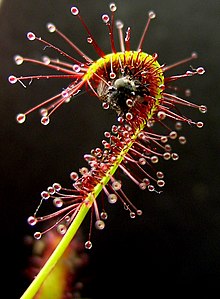Drosera capensis
| Cape sundew | |
|---|---|
 |
|
| Scientific classification | |
| Kingdom: | Plantae |
| (unranked): | Angiosperms |
| (unranked): | Eudicots |
| (unranked): | Core eudicots |
| Order: | Caryophyllales |
| Family: | Droseraceae |
| Genus: | Drosera |
| Species: | D. capensis |
| Binomial name | |
|
Drosera capensis L. |
|
Drosera capensis, commonly known as the Cape sundew, is a small rosette-forming carnivorous species of perennialsundew native to the Cape in South Africa. Because of its size, easy to grow nature, and the copious amounts of seed it produces, it has become one of the most common sundews in cultivation. D. capensis produces strap-like leaves, up to 3.5 centimetres (1.4 in) long (not including the petiole) and 0.5 centimetres (0.2 in) wide, which, as in all sundews, are covered in brightly coloured tentacles which secrete a sticky mucilage that traps arthropods. When insects are first trapped, the leaves roll lengthwise by thigmotropism toward the center. This aids digestion by bringing more digestive glands in contact with the prey. This movement is surprisingly fast, with completion in thirty minutes. The plant has a tendency to retain the dead leaves of previous seasons, and the main stem of the plant can become quite long and woody with time.
In early summer or late spring, D. capensis produces multiple, small, five-petaled pink flowers at the end of scapes which can be up to 30 centimetres (1 ft) tall. Flowers individually open in the morning and close by mid afternoon, lasting just one day each with the next one up the scape opening the following day; the lower ones on the scape can thus be open or "past" while the ones at the top are still forming. The flowers can self-pollinate upon closing and produce copious quantities of very small, spindle-shaped seeds, which are released from the capsules that form when the flowers have died. Under horticultural conditions, carnivorous plant enthusiasts find that these seeds have a tendency to find their way into neighbouring plant pots where they germinate readily, giving D. capensis a reputation as a weed.
Drosera capensis has several forms or varieties, including the "typical", "wide-leaved", "narrow-leaved" and "red" forms and the cultivar Drosera 'Albino'. The typical form is noted for wider leaves and the gradual production of a scrambling stem as it grows. The "wide-leaved" form is similar to the "typical" variety, but produces leaves at least 50% wider than the typical variety. The narrow-leaved form differs from the typical form in that it rarely produces tall stems; has thinner, longer leaves and less hair on the plant. Drosera capensis 'Albino', is also similar in shape to the "typical" form, but lacks most of the red pigmentation of the typical or narrow forms, with clear or pink trichomes and white flowers. There is also the "red" form that turns blood red in full sunlight, and is also similar physically to the narrow-leaved form. These varieties are commercially available.
...
Wikipedia
